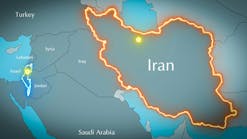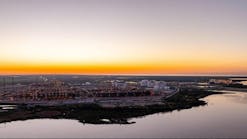Major investment is needed by 2005 to support a needed expansion of Europe's long distance gas transportation infrastructure.
So concludes European Investment Bank (EIB), Luxembourg.
The bank said western European gas demand could increase from 330 billion cu m/year currently to about 390 billion cu m in 2000 and 410-450 billion cu m in 2010.
Demand from the power generation market will grow faster than other sectors, said the bank, with all the increase being met by imports.
Increasing imports
"The growing demand will require more gas imports," EIB said, "given the expected stagnation of domestic gas production in Europe around the present level of 200 billion cu m/year.
"As a result, western Europe's outside dependence will increase from about 30% at present to about 40% in 2005. Algeria, Russia, and Norway can cover the gap between western European demand and production, up to and beyond 2010."
The bank said Europe does not need alternative gas supplies to these, although new long distance suppliers could be called upon in a bid to diversify supply sources.
Qatar, Iran, Abu Dhabi, and Trinidad, for example, could supply as much as a combined 100 billion cu m/year of gas to Europe, said the bank, but this would be more expensive than gas from Algeria, Russian and Norway.
Investment requirements are expected to be high whatever the gas sources, with current import capacity of 200 billion cu m/year through pipelines and 40 billion cu m/year of liquefied natural gas (LNG) insufficient to meet western and eastern Europe's growing need for imports.
Algeria, Norway exports
Algeria's official export target of 60 billion cu m/year is consistent with its current investment program, said the bank.
Planned work includes increasing capacity of the Transmed pipeline to Italy, completion of the GME pipeline to Spain, and upgrading of LNG export facilities.
The GME export pipeline capacity could be expanded, but there are no immediate plans for this.
Norway's gas exports of 30 billion cu m/year are expected to double in the next 10 years. This will require additional transport capacity.
The bank noted Norway is about to start construction of the NorFra pipeline to France and intends to build a new pipeline to Germany, Europipe II.
"The next step, if required, would be to upgrade an existing pipeline, possibly Zeepipe."
Russian exports
Russia's expected sales to eastern and western Europe should be more than 125 billion cu m in 2000, exceeding current transportation capacity.
The bank said upgrading the existing export pipeline to 140 billion cu m/year capacity might just enable Russia to meet eastern Europe's expected demand plus western Europe's signed contracts to 2005.
"However, new contracts between western Europe and Russian will require a new trunkline," EIB said. "There are firm plans to build a gas pipeline to link Russia to Germany through Poland and Belarus.
"The full cost of this Yamal pipeline project, from Germany to the Yamal Peninsula, is estimated at $30 billion. The first phase of the project, from Germany to Torzhok between Moscow and St. Petersburg, is likely to be less than $10 billion.
"So far, financing has not been arranged, and there are serious doubts as to whether Belarus and Russia will be able to finance their part of the pipeline, without which the German and Polish parts of the project would be useless."
Yet contracts either existing or under negotiation could lead to excess gas supply in Europe until 2000, said the bank, leading to a fall in prices at a time when new gas infrastructure investments need to be made.
"The mechanisms for such a fall in prices," EIB said, "could be exports of British gas through the U.K.-Continent Interconnector or aggressive marketing by Russia's Gazprom."
Copyright 1996 Oil & Gas Journal. All Rights Reserved.

